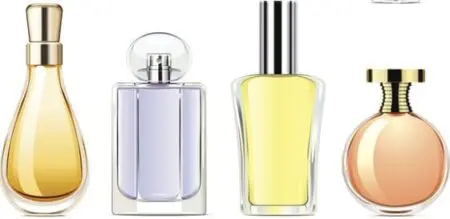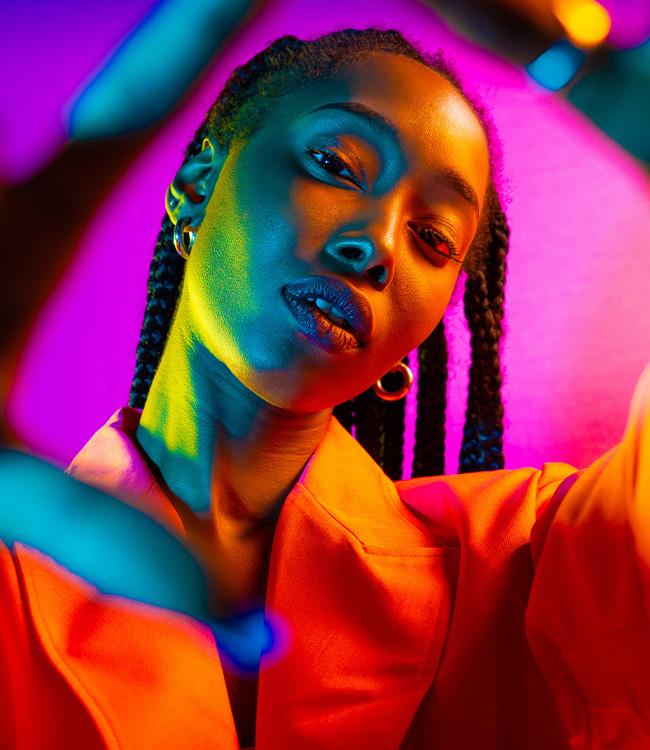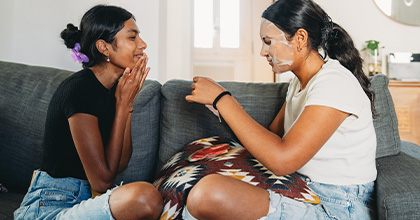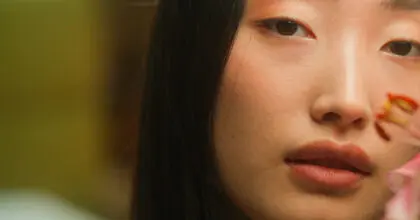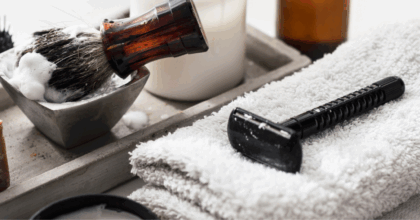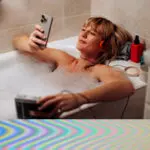The Key Notes Transforming the Fragrance Industry
Over the past five years, the fragrance industry has experienced a dynamic evolution. From escapist scent preferences during the height of the COVID-19 pandemic to a post-lockdown surge in expressive, identity-driven choices, consumer behaviour in the fragrance industry has mirrored broader societal shifts. Ongoing economic pressure during the cost-of-living crisis has driven shoppers to weigh value more heavily, prompting a more intentional approach to purchases. At the same time, the demand for sensory experiences that spark joy, nostalgia, or calm has continued to grow.
What are consumers looking for in perfumes today?
Today’s consumers are increasingly scrutinising ingredients. They are drawn to products that are safe, transparent, and emotionally resonant. While mass-market perfumes retain appeal, interest in both luxury and niche fragrances is rising, especially those that offer added benefits like mood enhancement or are personalised to the wearer. These intersecting forces are reshaping fragrance industry trends globally, opening new doors for scent marketing, innovation, and consumer engagement.
What are the Top Fragrance Trends in 2025?
The top fragrance trends in 2025 are shaped by four key forces: identity, wellness, climate, and digital culture. As consumers are simultaneously more value-driven and experience-focused, the fragrance industry is responding with bolder formats, functional benefits, and more inclusive messaging. Below, we explore the standout fragrance market trends reshaping the landscape.
Niche perfumes are gaining popularity
One of the most influential fragrance industry trends of recent years is the growing popularity of niche perfumes. These scents appeal to younger consumers, particularly Gen Z and Millennials, who increasingly view fragrance as a tool for self-expression: almost 45% of under-45-year-olds use fragrances to express themselves through scent. Niche brands often offer unconventional scent profiles, story-driven branding, and unique formats such as oils, solids, or hair perfumes.
Urban Gen Z in particular are driving this trend, drawn to fragrance layering and personalisation. Discovery sets and paid-for sampling have also become more common, allowing shoppers to experiment with scent without committing to a full-size bottle. Viral micro-trends on social platforms like TikTok and Instagram amplify demand, especially among Gen Z fragrance trend followers looking to stay culturally current.
Even major fragrance houses are entering the niche space, either through acquisition or by launching their own sub-lines, blending exclusivity with visibility.
Genderless fragrances are on trend
Fragrance brands are increasingly stepping away from rigid gender binaries, reflecting broader cultural conversations around identity and inclusion. Genderless or unisex perfumes are gaining traction, especially among Gen Z, who often reject traditional classifications in favour of individuality.
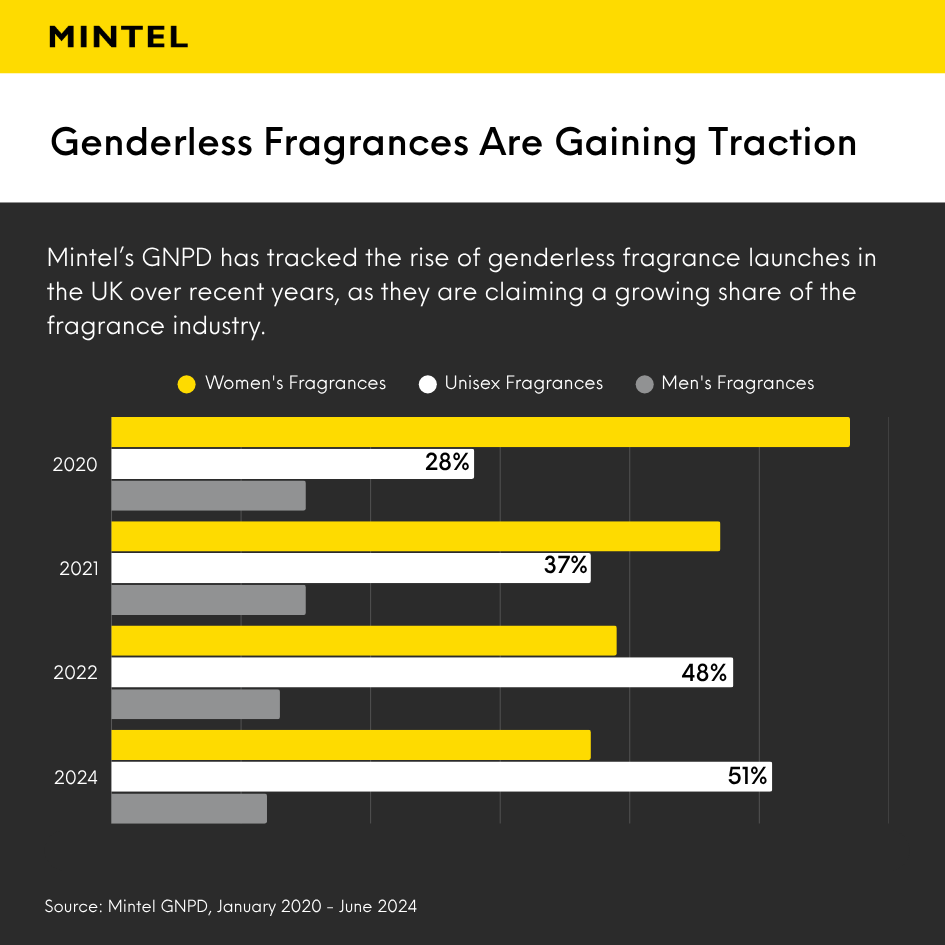
This inclusive shift is driving a rise in unisex product launches globally. Gender-neutral scents typically feature balanced blends of traditionally masculine and feminine notes, such as wood, spice, florals, or musk, appealing to those seeking freedom of expression over conformity.
Scent and emotion: the mood-boosting power of perfume
Another key perfume trend is the increasing focus on emotional wellbeing. Consumers are looking for fragrances that do more than smell nice. Perfumes designed to enhance mood, reduce stress, or evoke specific emotions like confidence, joy, or calm are in demand.
Charlotte Tilbury’s “Collection of Emotions,” for instance, includes six scents tailored to feelings such as seduction, empowerment, and happiness. These neuro-fragrances often incorporate ingredients said to boost endorphins or lower cortisol, positioning perfume as part of a broader self-care and wellness routine.
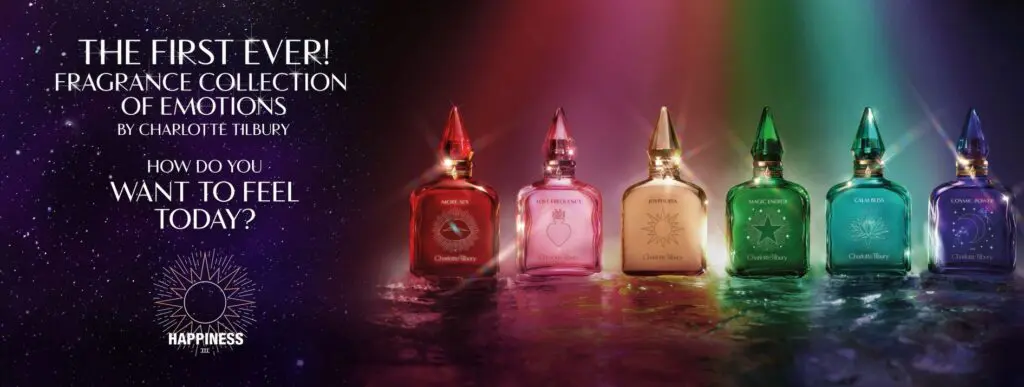
With over half of UK fragrance users using scent to lift their mood, the opportunity for wellness-integrated fragrance marketing is significant.
Functional fragrances are going mainstream
As the boundaries between beauty, health, and wellness continue to blur, fragrance products are being reimagined as tools for mental and physical wellbeing. From aromatherapy scents to perfumes that claim to support sleep, focus, or weight management, the future fragrance trends centre around functionality: 79% of users in Germany believe fragrance can positively impact mental wellbeing.
The Scent of Change: Navigating a New Fragrance Era
Rapid changes in the fragrance industry mean that brands need to embrace bold innovation and strategic reinvention to remain competitive in scent marketing.
To do so, brands are redefining what luxury means in 2025, prioritising sustainability, exploring cutting-edge technologies like AI, and tapping into nostalgia-driven marketing on platforms like TikTok. Explore these areas with Mintel below.
1. What Does Luxury Mean in Fragrance in 2025?
Luxury in 2025 is about substance, story, and sensory experience. While designer names still carry weight, today’s fragrance consumers are seeking something more intimate: craftsmanship, authenticity, and emotional connection.
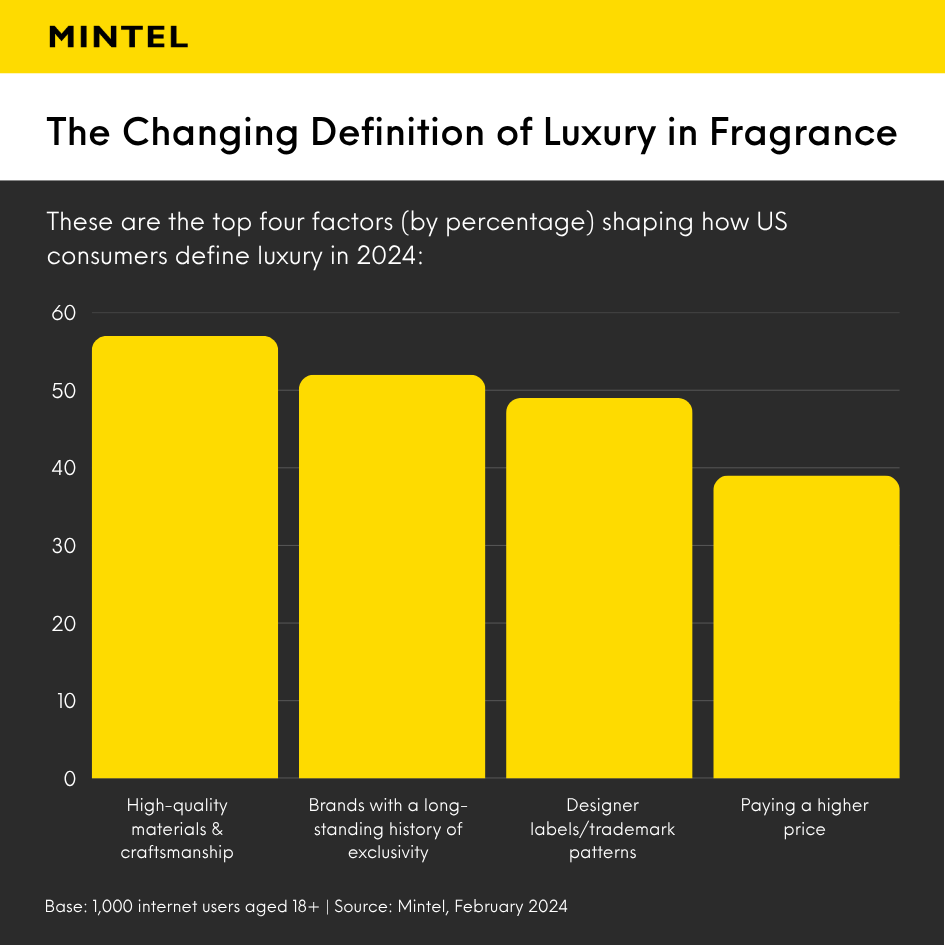
• Craftsmanship, storytelling, and the rise of ‘slow perfume’
For many, true luxury lies in the details. High-quality materials, artisanal production, and long-lasting scent performance are key. Emotional storytelling and exclusivity also play a critical role.
Whether it’s a heritage house or a limited-edition drop, successful luxury perfumes craft a compelling narrative. Personalised scent experiences, bespoke formulations, and immersive retail spaces further enhance perceived value.
Minimalist and meaningful, quiet luxury that is refined, subtle, and rooted in intention continues to resonate with this audience.
• Luxury as affordable indulgence
At the same time, economic pressures have redefined how people engage with prestige, causing fragrance to be perceived as affordable luxury. Consumers may forgo couture but still invest in a beautifully crafted scent, either for themselves or as a gift.
Brands are responding with flexible pricing, elevated packaging, and exclusive launches that feel premium without being out of reach. In markets like Japan, luxury fragrance is seamlessly incorporated into daily rituals, reflecting a shift toward personal, lived-in opulence.
2. Sustainable Perfume Trends: The Fragrance Industry Is Becoming More Eco-Friendly
Sustainability has shifted from a differentiator to a baseline expectation in the fragrance industry. As environmental concerns intensify, today’s consumers demand transparency, ethical sourcing, and eco-conscious innovation across the entire product lifecycle. In 2025, sustainability is shaping everything from scent formulation to packaging design.
• Sustainability and performance go hand-in-hand
Eco-conscious shoppers are no longer willing to compromise on quality. Long-lasting scents, which are particularly important in warmer climates, are increasingly prioritised. Between 2019 and 2023, long-wear claims on global fragrance launches more than tripled, rising from 11% to 35%, underlining a growing demand for efficacy and endurance.
• Are lab-grown perfumes the future of fragrance?
Fragrance brands are turning to biotechnology and upcycling to reduce their environmental footprint. Lab-grown molecules and precision fermentation offer greater purity, consistency, and reduced dependence on natural resources. Meanwhile, upcycled ingredients, such as Sylvamber, derived from recycled cedarwood, bring sophistication and sustainability together. Ellis Brooklyn’s Dear Sky, featuring seven upcycled ingredients, is a standout example.
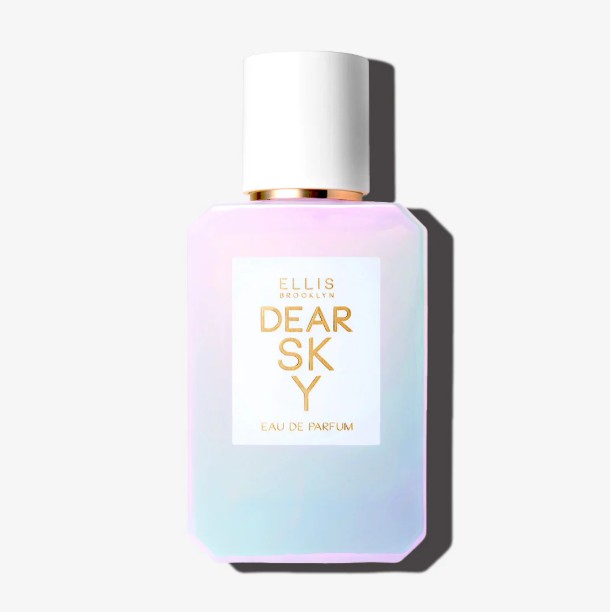
• Packaging innovation in the fragrance industry
Packaging innovation is key to closing the loop. Lightweight materials, refillable formats, and reduced plastic are becoming standard. Luxury brands like Verescence and Ere Perez are leading the charge with sustainable designs that don’t compromise on premium appeal.
In markets like Japan, clean claims, including alcohol-free, allergen-free, and eco-safe, are moving into the mainstream. To remain competitive, brands must evolve their packaging and messaging to match rising consumer expectations.
3. How Is AI Changing the Fragrance Industry?
Artificial intelligence is quietly transforming how fragrances are imagined, marketed, and sold. As one of the most future-forward fragrance industry trends, AI is accelerating innovation, enhancing personalisation, and bridging the gap between online and in-store discovery.
• From creation to customisation
AI tools help perfumers analyse ingredient data and predict successful scent combinations based on preferences and regional trends, accelerating product development and allowing for more targeted formulations from Gen Z’s mood-based choices to Millennials’ clean-label preferences.
• Personalised discovery and digital engagement
From online quizzes to in-store diagnostics, AI tools guide consumers toward scents that align with their personality, mood, or lifestyle. These technologies enhance scent marketing and improve the path to purchase.
4. Scent Marketing Through Nostalgia and TikTok Culture
To connect with Gen Z and Gen Alpha in 2025, fragrance brands are leaning into emotional storytelling, digital engagement, and innovative scent marketing. These younger consumers value authenticity, sensory appeal, and products that feel personal.
Reflecting this focus on sensory appeal, Boots is opening its first fragrance-only store in London. The sensory-led Boots Fragrance boutique is part of the UK retailer’s plans to invest significantly in its store portfolio and follows a period of solid growth in its perfume sales.
• What’s behind the rise of nostalgic scents?
Fragrances that evoke comfort, joy, and familiarity are gaining popularity, especially among younger audiences. Brands are reviving classics like Clinique’s ‘Happy’ with updated formulas and storytelling that tap into “newstalgia”: scent marketing with a retro appeal reimagined for modern tastes.
• What kind of scents are popular on TikTok?
Social media, particularly TikTok’s thriving ‘FragranceTok’ space, is driving new forms of discovery. Viral trends, such as “bedtime perfume” or functional AM/PM scents, show how Gen Z approaches fragrance as both self-expression and self-care. With over 278 million posts as of October 2024, TikTok has become a key platform for shaping scent trends.
Brands like Sol de Janeiro have mastered this space, using sensory-driven storytelling, influencer partnerships, and value-focused pricing to achieve cult status on social media. Their success highlights how tapping into cultural rituals and digital-first marketing can build deep loyalty with younger customers.
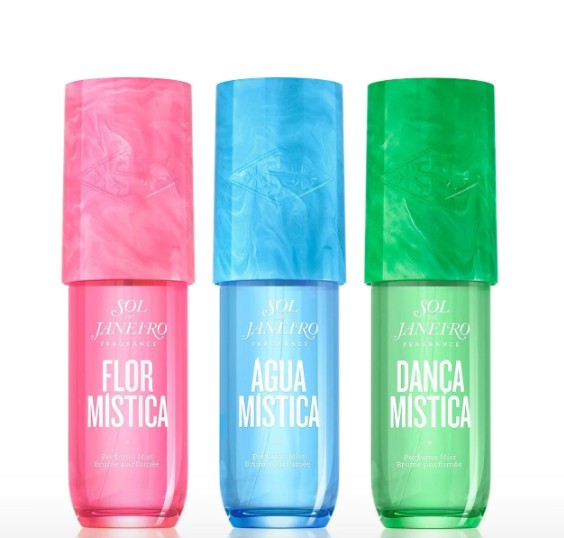
Prepare for Future Fragrance Industry Trends with Mintel
As consumer expectations evolve, the fragrance industry is stepping up with products that fuse luxury and utility, heritage and innovation, identity and wellbeing.
From genderless and niche expressions to AI-assisted creation and sustainable packaging, today’s fragrance market trends reflect a broader shift toward individuality, clarity, and care. Gen Z and Millennial consumers are shaping the narrative, seeking scents that align with their values and amplify their voices.
Looking ahead, fragrance industry trends will continue to blur the boundaries between beauty and health, digital and physical, mass and prestige. For brands and marketers, the opportunity lies in creating olfactory experiences that are as nuanced and expressive as the people who wear them.
Is your business ready for the next five years? Don’t just react to market shifts, anticipate them. From in-depth consumer reports revealing evolving attitudes to bespoke growth strategies tailored to your unique needs, we’ve got you covered. Dive into The Future of Fragrance to unlock crucial insights on global trends anticipated over the next five years or explore A Year of Innovation in Fragrances to discover the breakthrough products shaping the industry.
Picked up the scent? Follow the trail for more industry insights by signing up to our free newsletter ‘Spotlight’. Or explore our comprehensive Beauty and Personal Care Market Research on Mintel Store.

